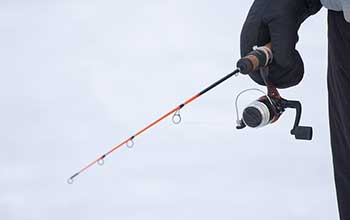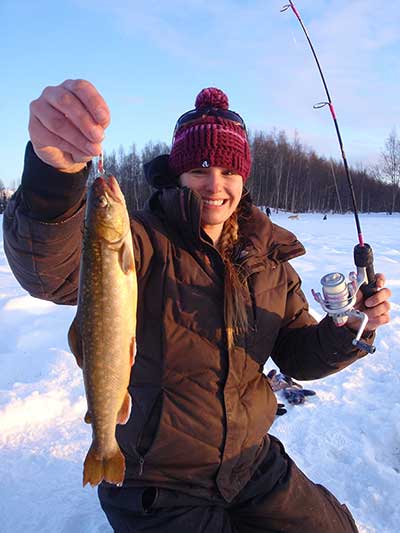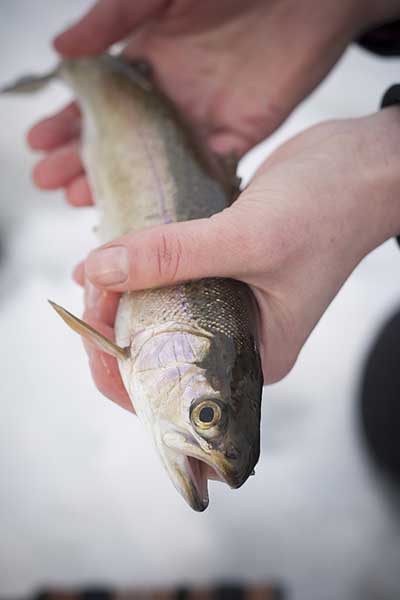Alaska Fish & Wildlife News
February 2015
Ice Fishing Stocked Lakes
in Anchorage and Beyond

Shortly before sunset I fire up my gas-powered ice auger and hold the throttle wide open as the sharp blades chew through a thick layer of ice. A stiff January breeze blows across the lake. It is two degrees below zero. We are preparing to fish a lake that I’ve never been to before. My kids run around on the ice, exploring the wide-open white plane, occasionally dropping their bodies down to carve out figures in the snow. I know with the wind-chill and it getting late in the day, this play will not last too long and we are not going to be able to spend as much time fishing as I would like. Regardless, I continue to drill holes in the ice, dropping the transducer from my ice-flasher down the open hole to check the depth of the water.
Knowing this lake is stocked by the Alaska Department of Fish and Game with rainbow trout and fingerling coho salmon, I search to find a depth of about 12 to 16 feet, which tends to be a promising depth to target rainbows. This is one of over 130 lakes in Southcentral Alaska that is stocked annually by ADF&G. It’s a fairly remote lake with easy public access away from the urban clutter of homes and vehicles. From the lack of obvious angling sign such as old ice holes, snowmachine tracks and human footprints, it’s clear this lake does not receive much angling pressure.
I drill five holes in a grid pattern that traverses a steep aquatic shelf defined only by the lines on my flasher and drop my small jig tipped with a fingernail-sized chunk of cured salmon roe down into the murky water. The weight of the jig pulls the line slowly down as a staggered gust of wind exhales against the clear evening cold. The line stops, coiling slightly atop the meniscus bound by the perfect circumference of hard water. I close the bail, reel some line in so that the jig is positioned a few inches from the bottom substrate and begin to lift the rod tip up and down in timed erratic motions, pausing occasionally to mimic the frantic motion of small aquatic life in the dark.
Within a few minutes I feel through the rod the reverberations of a hungry fish tapping the jig below. The strike is small. I lift the jig slightly, imagining a childhood game of keep-away. Another small strike; I lower the jig and pause. The fish mouths the stagnant jig with more aggression and I pull the rod tip up, setting the hook in the assertive flesh. The fish reacts instantly as if drawn forcefully from a disturbing dream. Line is pulled freely against the buzz of the drag as the fish swims on. I hold the rod tightly and wait for the fish to pause before applying pressure to the reel. With a few cranks I gain a little line back and the fish responds by turning and swimming harder and faster than before. This goes on in immeasurable frames of time during which there is no cold, no wind, no breath, just the hard pull of a large fish beneath a frozen surface on a quiet lake somewhere in Alaska, where memory is always shrouded by winter.
It wasn’t until about a year ago that I really begin to take ice fishing seriously. Up till then, I spent a large part of my free-time during winter running a trapline outside of Fairbanks or placing setlines for burbot on the Tanana River. During my first winter in the Anchorage area, I developed an interest in ice fishing when a colleague of mine showed me a few photos of some of the fish he’d caught that winter on one of the local stocked lakes. The photos showed an impressive Arctic char that had been taken from a lake no more than five miles from my office. I recognized the fish as one of the brood char raised and stocked by staff at the William Jack Hernandez Sport Fish Hatchery in Anchorage. These large fish are released in a few of the local lakes after spawning and average roughly five pounds.

Aside from the photo of the monster Arctic char, my colleague told stories of days spent ice fishing where it was not uncommon to catch upwards of 40 fish per day. Not all would be Arctic char pushing five pounds, but the thought of high catch rates and the fact that I wanted to get into ice fishing led to me joining him on one of his ice fishing excursions.
I learned quickly that, as with any form of angling, there are multiple species to target using myriad methods and more tackle and gear available to anglers that make it quite difficult to know where to begin. I’ll briefly cover a few of the most common ice fishing necessities one can begin using to specifically target fish species in stocked lakes in and around the Anchorage area. One could easily spend significant amounts of money and an equal number of years acquiring various types of ice fishing gear for fish species in Alaska. But the good news is ice fishing can be done on a small budget and with minimal gear.
The main component to keep in mind when preparing to go ice fishing is personal safety. The first question should be, is the ice safe? This comes down to personal preference and comfort level. Some anglers and online sources indicate that at least 4 inches of good, solid ice is acceptable to walk on. I prefer at least six inches of ice and feel most comfortable when the ice is 8 inches thick or more. It’s also good to keep in mind that on some lakes – especially those with active underwater springs – ice thickness can vary across the lake. Of course the best preventative measure is to practice common sense and be prepared for fishing conditions. In some areas, there are agencies that monitor ice thickness throughout winter. I find a simple search online will turn up a few sources in most areas. Anglers can also contact their local ADF&G office with questions related to ice fishing conditions in their area.
When it comes to preparing to go ice fishing, there are a few obvious factors that should be considered before hitting the ice. The first being weather. It’s winter. It’s going to be cold. Dress appropriately and bring extra gear such as gloves and hats. It’s difficult to over-prepare for cold weather and far more difficult to keep warm in a pair of blue jeans and a light coat. This may seem rudimentary to some, but I’ve seen a number of inexperienced ice anglers braving the elements in little more than a pair of uninsulated hiking boots, a ball cap and Carhartts.
Secondly, ice fishing tackle and gear differs from open-water gear. Ice fishing rods are more often shorter than open-water rods. There are also tip-ups, which sit atop the ice hole and are designed to release an indicating “flag” when a fish strikes the bait. Ice fishing tackle can include a wide variety of jigs, spoons and lures. The use of live bait in freshwaters of Alaska is prohibited, but cured salmon roe and shrimp are very common types of bait used while ice fishing for species such as rainbow trout, Arctic char, grayling and landlocked salmon. While bait is legal to use on most – but not all – stocked lakes in Southcentral, it’s always a good idea to check sport fish regulations before heading out. Anglers can also contact the Sport Fish Information Center in Anchorage at 907-267-2218 with any sport fish related questions.

While ice fishing on many of the stocked lakes in Southcentral, anglers can use no more than two closely attended lines, provided only one hook or artificial lure is used on each line. There are exceptions in that on some lakes additional gear may be used to target northern pike or burbot. Refer to Southcentral sport fish regulations for more information on ice fishing gear for northern pike or burbot.
In addition to ice fishing tackle and gear, anglers need a way to break through the ice. Drilling a hole in the ice requires an ice auger with sharp blades. There are several different ice augers available with various diameters that include hand-crank augers, gas powered augers, propane-powered augers and even battery-powered augers. Common diameters are 8 and 10 inch augers. Some anglers use a spud-bar, or ice chipper to chisel their way through the ice. Probably the most effective and efficient way to drill a hole in the ice is through the use of a powered auger. Hand-crank augers with sharp blades work well, but the onus of power is on the angler. When I was running set-lines for burbot on the Tanana River outside of Fairbanks, I used a hand-crank auger. It took a while to cut through three feet of ice, but I managed to drill four or five holes before losing what little winter light fell upon the December river.
Then there are fancy electronic gadgets that read water depth and spot fish; cameras with LED illumination attached to a small color monitor that allow anglers to see what’s under ice. There are ice tents, sleds, rod holders, chairs, portable heaters – a veritable list of other items available to avid ice anglers. Just what we all need, more stuff. But in reality, ice anglers in and around the Anchorage or Mat-Su areas who are prepared for the elements can find success with minimal ice fishing gear.
And, with help from the ADF&G Rod Loaner Program, acquiring the necessary gear is easy.
ADF&G Rod Loaner Program
For those anglers who would like to go ice fishing and who do not have the means or the desire to purchase the necessary gear, the Alaska Department of Fish & Game has ice fishing equipment to loan free of charge. This program is open to any licensed angler and offers ice fishing rods, augers, buckets and ice scoops. ADF&G offices in Southcentral that participate in the Rod Loaner Program are located in Anchorage, Palmer and Homer. Offices also loan open-water fishing gear.
For more information on the Rod Loaner Program, download this brochure.
ADF&G Stocked Lakes
The Alaska Department of Fish & Game annually stocks thousands of landlocked salmon (coho and chinook), rainbow trout, Arctic char and Arctic grayling in lakes throughout Southcentral. Not all lakes are stocked with all of the aforementioned species, but many lakes provide angling opportunity for multiple species of fish. Information on stocked lakes throughout the state is continuously updated and can be found on ADF&G’s website.

Other stocked lakes resources include the Anchorage-area stocked lakes info on the ADF&G website, as well as Mat-Su Valley stocked lakes, and stocked lakes on the Kenai Peninsula.
Non-stocked species
In many of the stocked lakes in Southcentral, there are fish species that simply don’t belong. Northern pike are considered an invasive species in Southcentral and inhabit many of the stocked and non-stocked waterways in the region. There is no limit and no closed season on northern pike and no live pike can be returned to the water in the freshwaters of West Cook Inlet and the Susitna River Drainage. Ice fishing for northern pike is growing in popularity in Southcentral. For those seeking more information on fishing for northern pike in Southcentral, ADF&G has a brochure, detailing information on the fish and showing locations of known pike infestations.
The Alaska blackfish is another introduced species commonly found in stocked waters in Anchorage and beyond. Like northern pike, there is no limit and no closed season on Alaska blackfish in Southcentral. Many anglers who are unfamiliar with Alaska blackfish often misidentify them as juvenile burbot. While it’s not a highly sought-after fish species, the Alaska blackfish is a hearty fish that has many historic traditional uses.
Long before the season’s first snowfall and prolonged cold weather, I sat in my office watching the air change and I set myself a laudable goal. I would not go ice fishing at the same lake twice during the winter, and I would commit myself to ice fishing on an unfamiliar stocked lake whenever I set out to fish. It’s late January and I’ve not accomplished all I set out to do. I’ve fished on certain lakes more than once and while I’ve ice fished at several unfamiliar locations, I’ve not gone far enough. With over 130 lakes in the region to fish I’ll stay as busy as I will allow myself to be.
I wish I could say that the fish I hooked on the quiet lake during a cold evening fishing with my family was a 20 inch rainbow trout that I held momentarily in my cold hand before releasing back to the dark aquatic beyond. The truth is, after a long battle the hook worked itself loose from the fish’s mouth and I never got a chance to set eyes on it. We caught several fish that evening, with my wife landing more than I did. My kids enjoyed landing a few themselves. While each fish was healthy, colorful and of adequate size, none compared to the one I lost.
Ryan Ragan is a writer and information officer with ADF&G's Sport Fish Division in Anchorage.
Subscribe to be notified about new issues
Receive a monthly notice about new issues and articles.
